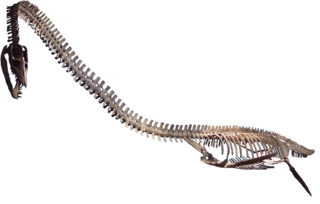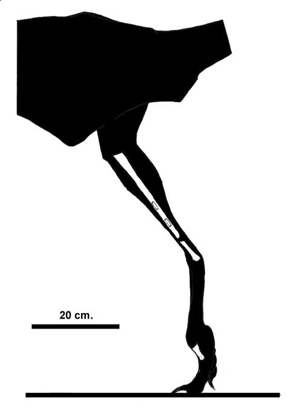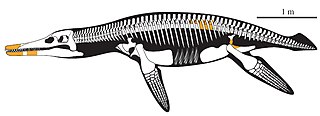The Mesozoic Era is the second-to-last era of Earth's geological history, lasting from about 252 to 66 million years ago, comprising the Triassic, Jurassic and Cretaceous Periods. It is characterized by the dominance of gymnosperms and of archosaurian reptiles, such as the dinosaurs; a hot greenhouse climate; and the tectonic break-up of Pangaea. The Mesozoic is the middle of the three eras since complex life evolved: the Paleozoic, the Mesozoic, and the Cenozoic.

Andamooka is a town approximately 600 km north of Adelaide in the Far North of South Australia on the lands of the Kokatha people. Andamooka is the largest town administered by the Outback Communities Authority instead of a local government area. It is in the state electoral district of Giles and the federal Division of Grey.

Ichthyosauria is an order of large extinct marine reptiles sometimes referred to as "ichthyosaurs", although the term is also used for wider clades in which the order resides.
Several groups of tetrapods have undergone secondary aquatic adaptation, an evolutionary transition from being purely terrestrial to living at least part of the time in water. These animals are called "secondarily aquatic" because although their ancestors lived on land for hundreds of millions of years, they all originally descended from aquatic animals. These ancestral tetrapods had never left the water, and were thus primarily aquatic, like modern fishes. Secondary aquatic adaptations tend to develop in early speciation as the animal ventures into water in order to find available food. As successive generations spend more time in the water, natural selection causes the acquisition of more adaptations. Animals of later generations may spend most their life in the water, coming ashore for mating. Finally, fully adapted animals may take to mating and birthing in water or ice.

The South Polar region of the Cretaceous comprised the continent of East Gondwana–modern day Australia, Zealandia, and Antarctica–a product of the break-up of Gondwana in the Cretaceous Period. The southern region, during this time, was much warmer than it is today, ranging from perhaps 4–8 °C (39–46 °F) in the latest Cretaceous Maastrichtian in what is now southeastern Australia. This prevented permanent ice sheets from developing and fostered polar forests, which were largely dominated by conifers, cycads, and ferns, and relied on a temperate climate and heavy rainfall. Major fossil-bearing geological formations that record this area are: the Santa Marta and Sobral Formations of Seymour Island off the Antarctic Peninsula; the Snow Hill Island, Lopez de Bertodano, and the Hidden Lake Formations on James Ross Island also off the Antarctic Peninsula; and the Eumeralla and Wonthaggi Formations in Australia.

Elasmosaurus is a genus of plesiosaur that lived in North America during the Campanian stage of the Late Cretaceous period, about 80.5 million years ago. The first specimen was discovered in 1867 near Fort Wallace, Kansas, US, and was sent to the American paleontologist Edward Drinker Cope, who named it E. platyurus in 1868. The generic name means "thin-plate reptile", and the specific name means "flat-tailed". Cope originally reconstructed the skeleton of Elasmosaurus with the skull at the end of the tail, an error which was made light of by the paleontologist Othniel Charles Marsh, and became part of their "Bone Wars" rivalry. Only one incomplete Elasmosaurus skeleton is definitely known, consisting of a fragmentary skull, the spine, and the pectoral and pelvic girdles, and a single species is recognized today; other species are now considered invalid or have been moved to other genera.

Kronosaurus is an extinct genus of short-necked pliosaurs that lived during the Early Cretaceous period in what is now Australia. It is a monotypic genus with one species K. queenslandicus, described in 1924 from the Toolebuc Formation in Queensland, Australia. With traditionally attributed fossils indicating a total length of up to 10 meters (33 ft), Kronosaurus may have been among the largest pliosaurs.

The Plesiosauria or plesiosaurs are an order or clade of extinct Mesozoic marine reptiles, belonging to the Sauropterygia.

Koolasuchus is an extinct genus of brachyopoid temnospondyl in the family Chigutisauridae. Fossils have been found from Victoria, Australia and date back 125-120 million years ago to Barremian-Aptian stages of the Early Cretaceous. Koolasuchus is the youngest known temnospondyl. It is known from several fragments of the skull and other bones such as vertebrae, ribs, and pectoral elements. The type species Koolasuchus cleelandi was named in 1997. K. cleelandi was adopted as the fossil emblem for the state of Victoria, Australia on 13 January 2022.

Kakuru is a dubious genus of theropod dinosaur from the early Cretaceous Period.

Umoonasaurus is an extinct genus of plesiosaur belonging to the family Leptocleididae. This genus lived approximately 115 million years ago during the Early Cretaceous period, in shallow seas covering parts of what is now Australia. It was a relatively small animal around 2.5 metres (8.2 ft) long. An identifying trait of Umoonasaurus is three crest-ridges on its skull.

Scanisaurus is a dubious genus of plesiosaur that lived in what is now Sweden and Russia during the Campanian stage of the Late Cretaceous period. The name Scanisaurus means "Skåne lizard", Skåne being the southernmost province of Sweden, where a majority of the fossils referred to the genus have been recovered. The genus contains one species, S. nazarowi, described in 1911 by Nikolay Bogolyubov as a species of Cimoliasaurus based on a single vertebral centrum discovered near Orenburg, Russia.
The Marree Subgroup, previously described as Maree Formation and Marree Formation, is a geological subgroup in the Eromanga Basin of South Australia whose strata date back to the Aptian. The subgroup was first described as a formation by Forbes in 1966. Dinosaur remains are among the fossils that have been recovered from the formation.
Eromangasaurus is an extinct genus of elasmosaurid known from northern Queensland of Australia.

Cardabiodon is an extinct genus of large mackerel shark that lived about 95 to 91 million years ago (Ma) during the Cenomanian to Turonian of the Late Cretaceous. It is a member of the Cardabiodontidae, a family unique among mackerel sharks due to differing dental structures, and contains the two species C. ricki and C. venator. Cardabiodon fossils have been found in Australia, North America, England, and Kazakhstan. It was likely an antitropical shark that inhabited temperate neritic and offshore oceans between 40° and 60° paleolatitude, similar to the modern porbeagle shark.

This timeline of plesiosaur research is a chronologically ordered list of important fossil discoveries, controversies of interpretation, taxonomic revisions, and cultural portrayals of plesiosaurs, an order of marine reptiles that flourished during the Mesozoic Era. The first scientifically documented plesiosaur fossils were discovered during the early 19th century by Mary Anning. Plesiosaurs were actually discovered and described before dinosaurs. They were also among the first animals to be featured in artistic reconstructions of the ancient world, and therefore among the earliest prehistoric creatures to attract the attention of the lay public. Plesiosaurs were originally thought to be a kind of primitive transitional form between marine life and terrestrial reptiles. However, now plesiosaurs are recognized as highly derived marine reptiles descended from terrestrial ancestors.

Makhaira rossica is an extinct genus and species of a marine reptile belonging to the family Pliosauridae. It lived during the early Cretaceous period, and its fossils have been found in Russia.

Arminisaurus is a genus of pliosaurid plesiosaur that lived during the Lower Jurassic in present-day Germany. With Westphaliasaurus and Cryonectes, Arminisaurus is only the third plesiosaurian taxon that was described from the Pliensbachian stage. The holotype and only known specimen is a fragmentary skeleton, comprising an incomplete lower jaw, teeth, vertebrae and elements from the pectoral girdle and the paddles. The animal had an estimated body length of 3–4 metres (9.8–13.1 ft).

The Kristianstad Basin is a Cretaceous-age structural basin and geological formation in northeastern Skåne, the southernmost province of Sweden. The basin extends from Hanöbukten, a bay in the Baltic Sea, in the east to the town of Hässleholm in the west and ends with the two horsts Linderödsåsen and Nävlingeåsen in the south. The basin's northern boundary is more diffuse and there are several outlying portions of Cretaceous-age sediments. During the Cretaceous, the region was a shallow subtropical to temperate inland sea and archipelago.
The Bulldog Shale is a formation of Early Cretaceous age that forms part of the Marree Subgroup of the Rolling Downs Group, located in the Eromanga Basin of South Australia, Queensland and New South Wales.























